University Name: Media Representation of Muslims in Various Platforms
VerifiedAdded on 2023/05/27
|10
|2283
|318
Report
AI Summary
This report analyzes the representation of Muslims in various media platforms, focusing on the analysis of online and traditional media materials. The assignment employs critical discourse analysis to examine the explicit and implicit meanings within the chosen media articles. It begins with a background on the topic, followed by the methodology, which includes the use of critical discourse analysis to investigate social ideologies and power dynamics. The report delves into stereotypical representations of Muslims, including themes of terrorism, male dominance, and cultural clashes, while also considering positive counter-images. The findings highlight how media portrayals can contribute to Islamophobia and the construction of Muslims as an 'other.' The report also touches on the impact of social media, the role of online communities, and the need for balanced representations to challenge existing stereotypes. The report concludes by emphasizing the importance of critical analysis and the need for media literacy in understanding the complex portrayals of Muslims in contemporary society, and also includes a literature review and a methodology section.
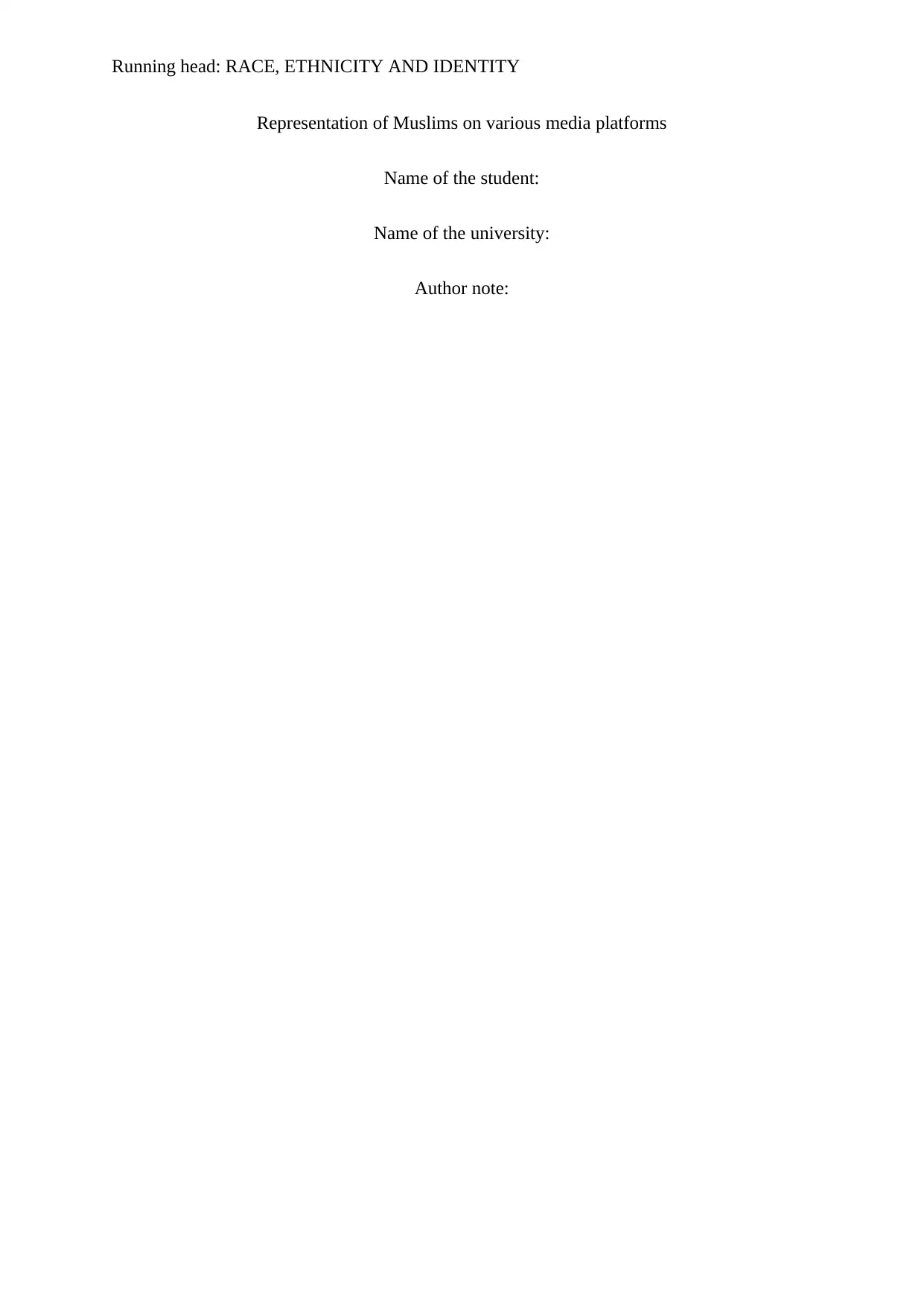
Running head: RACE, ETHNICITY AND IDENTITY
Representation of Muslims on various media platforms
Name of the student:
Name of the university:
Author note:
Representation of Muslims on various media platforms
Name of the student:
Name of the university:
Author note:
Paraphrase This Document
Need a fresh take? Get an instant paraphrase of this document with our AI Paraphraser
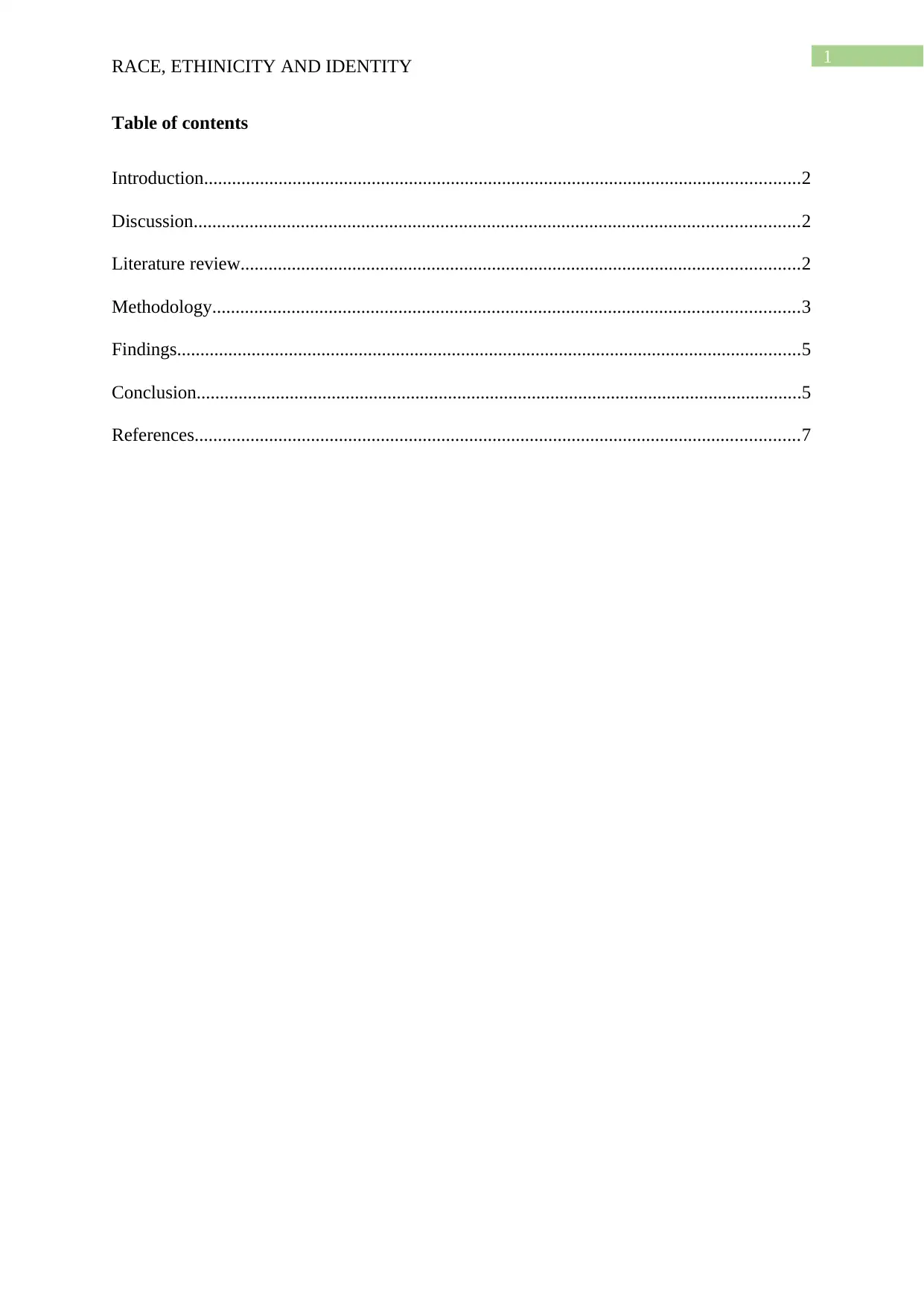
1
RACE, ETHINICITY AND IDENTITY
Table of contents
Introduction................................................................................................................................2
Discussion..................................................................................................................................2
Literature review........................................................................................................................2
Methodology..............................................................................................................................3
Findings......................................................................................................................................5
Conclusion..................................................................................................................................5
References..................................................................................................................................7
RACE, ETHINICITY AND IDENTITY
Table of contents
Introduction................................................................................................................................2
Discussion..................................................................................................................................2
Literature review........................................................................................................................2
Methodology..............................................................................................................................3
Findings......................................................................................................................................5
Conclusion..................................................................................................................................5
References..................................................................................................................................7
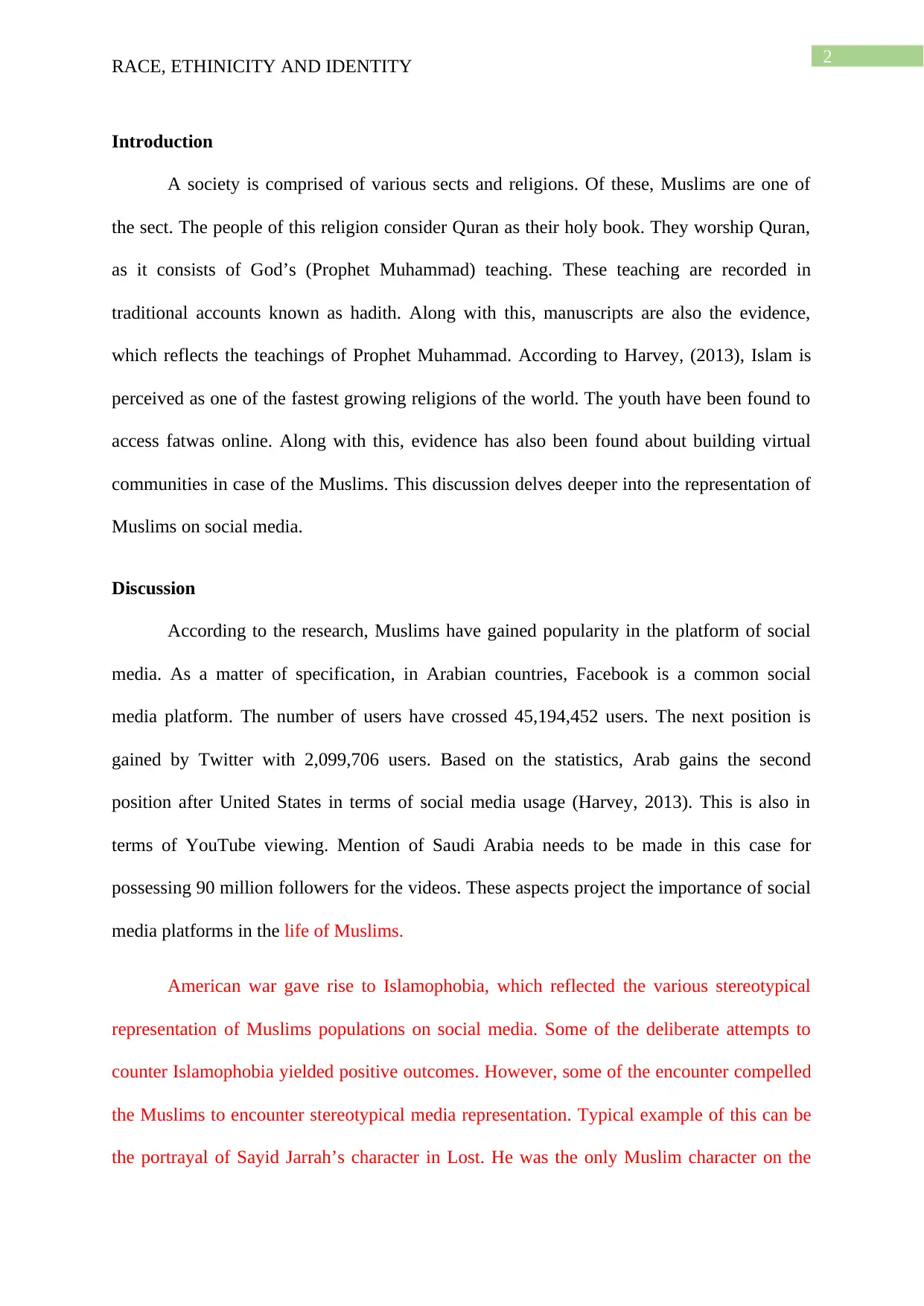
2
RACE, ETHINICITY AND IDENTITY
Introduction
A society is comprised of various sects and religions. Of these, Muslims are one of
the sect. The people of this religion consider Quran as their holy book. They worship Quran,
as it consists of God’s (Prophet Muhammad) teaching. These teaching are recorded in
traditional accounts known as hadith. Along with this, manuscripts are also the evidence,
which reflects the teachings of Prophet Muhammad. According to Harvey, (2013), Islam is
perceived as one of the fastest growing religions of the world. The youth have been found to
access fatwas online. Along with this, evidence has also been found about building virtual
communities in case of the Muslims. This discussion delves deeper into the representation of
Muslims on social media.
Discussion
According to the research, Muslims have gained popularity in the platform of social
media. As a matter of specification, in Arabian countries, Facebook is a common social
media platform. The number of users have crossed 45,194,452 users. The next position is
gained by Twitter with 2,099,706 users. Based on the statistics, Arab gains the second
position after United States in terms of social media usage (Harvey, 2013). This is also in
terms of YouTube viewing. Mention of Saudi Arabia needs to be made in this case for
possessing 90 million followers for the videos. These aspects project the importance of social
media platforms in the life of Muslims.
American war gave rise to Islamophobia, which reflected the various stereotypical
representation of Muslims populations on social media. Some of the deliberate attempts to
counter Islamophobia yielded positive outcomes. However, some of the encounter compelled
the Muslims to encounter stereotypical media representation. Typical example of this can be
the portrayal of Sayid Jarrah’s character in Lost. He was the only Muslim character on the
RACE, ETHINICITY AND IDENTITY
Introduction
A society is comprised of various sects and religions. Of these, Muslims are one of
the sect. The people of this religion consider Quran as their holy book. They worship Quran,
as it consists of God’s (Prophet Muhammad) teaching. These teaching are recorded in
traditional accounts known as hadith. Along with this, manuscripts are also the evidence,
which reflects the teachings of Prophet Muhammad. According to Harvey, (2013), Islam is
perceived as one of the fastest growing religions of the world. The youth have been found to
access fatwas online. Along with this, evidence has also been found about building virtual
communities in case of the Muslims. This discussion delves deeper into the representation of
Muslims on social media.
Discussion
According to the research, Muslims have gained popularity in the platform of social
media. As a matter of specification, in Arabian countries, Facebook is a common social
media platform. The number of users have crossed 45,194,452 users. The next position is
gained by Twitter with 2,099,706 users. Based on the statistics, Arab gains the second
position after United States in terms of social media usage (Harvey, 2013). This is also in
terms of YouTube viewing. Mention of Saudi Arabia needs to be made in this case for
possessing 90 million followers for the videos. These aspects project the importance of social
media platforms in the life of Muslims.
American war gave rise to Islamophobia, which reflected the various stereotypical
representation of Muslims populations on social media. Some of the deliberate attempts to
counter Islamophobia yielded positive outcomes. However, some of the encounter compelled
the Muslims to encounter stereotypical media representation. Typical example of this can be
the portrayal of Sayid Jarrah’s character in Lost. He was the only Muslim character on the
⊘ This is a preview!⊘
Do you want full access?
Subscribe today to unlock all pages.

Trusted by 1+ million students worldwide
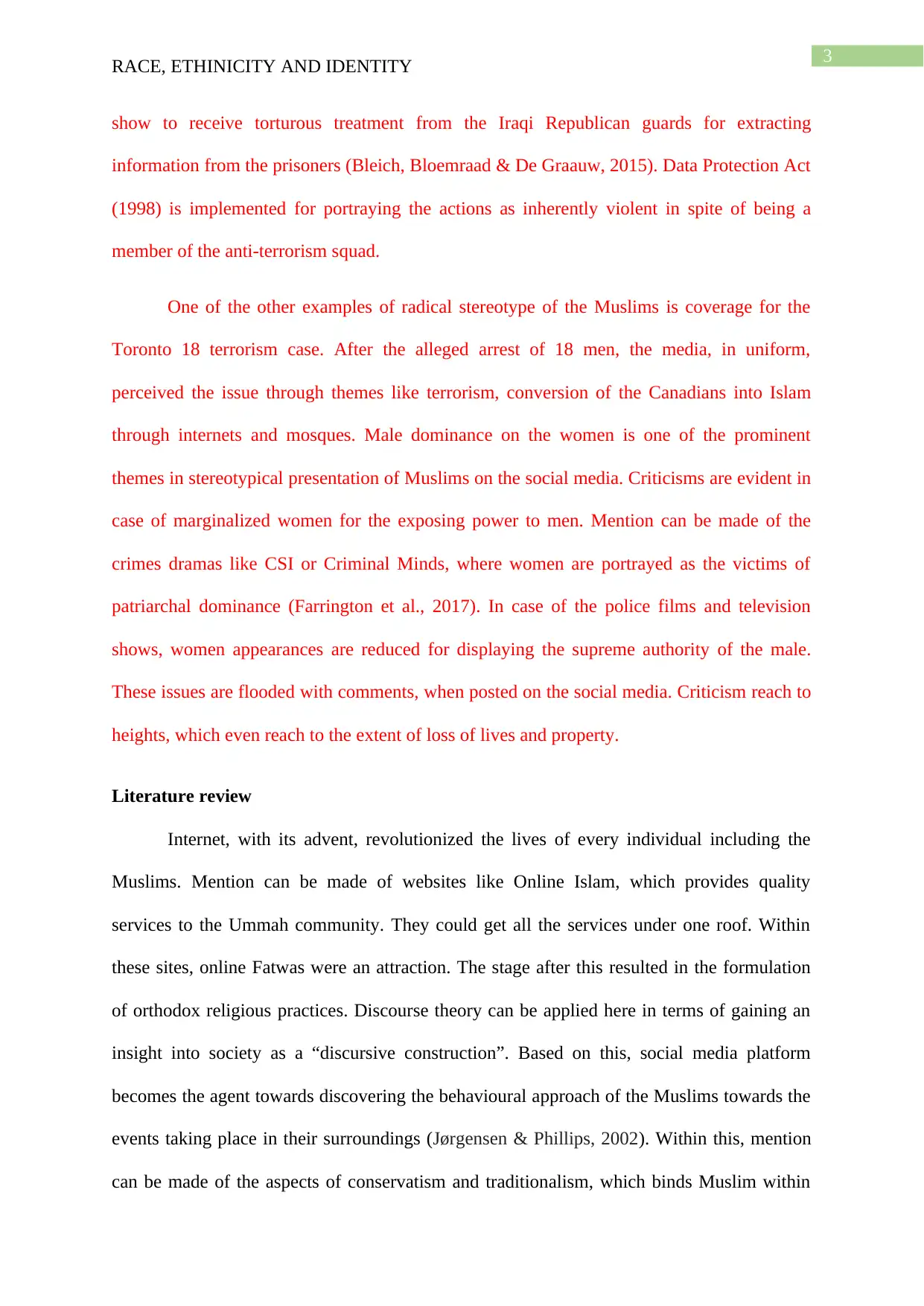
3
RACE, ETHINICITY AND IDENTITY
show to receive torturous treatment from the Iraqi Republican guards for extracting
information from the prisoners (Bleich, Bloemraad & De Graauw, 2015). Data Protection Act
(1998) is implemented for portraying the actions as inherently violent in spite of being a
member of the anti-terrorism squad.
One of the other examples of radical stereotype of the Muslims is coverage for the
Toronto 18 terrorism case. After the alleged arrest of 18 men, the media, in uniform,
perceived the issue through themes like terrorism, conversion of the Canadians into Islam
through internets and mosques. Male dominance on the women is one of the prominent
themes in stereotypical presentation of Muslims on the social media. Criticisms are evident in
case of marginalized women for the exposing power to men. Mention can be made of the
crimes dramas like CSI or Criminal Minds, where women are portrayed as the victims of
patriarchal dominance (Farrington et al., 2017). In case of the police films and television
shows, women appearances are reduced for displaying the supreme authority of the male.
These issues are flooded with comments, when posted on the social media. Criticism reach to
heights, which even reach to the extent of loss of lives and property.
Literature review
Internet, with its advent, revolutionized the lives of every individual including the
Muslims. Mention can be made of websites like Online Islam, which provides quality
services to the Ummah community. They could get all the services under one roof. Within
these sites, online Fatwas were an attraction. The stage after this resulted in the formulation
of orthodox religious practices. Discourse theory can be applied here in terms of gaining an
insight into society as a “discursive construction”. Based on this, social media platform
becomes the agent towards discovering the behavioural approach of the Muslims towards the
events taking place in their surroundings (Jørgensen & Phillips, 2002). Within this, mention
can be made of the aspects of conservatism and traditionalism, which binds Muslim within
RACE, ETHINICITY AND IDENTITY
show to receive torturous treatment from the Iraqi Republican guards for extracting
information from the prisoners (Bleich, Bloemraad & De Graauw, 2015). Data Protection Act
(1998) is implemented for portraying the actions as inherently violent in spite of being a
member of the anti-terrorism squad.
One of the other examples of radical stereotype of the Muslims is coverage for the
Toronto 18 terrorism case. After the alleged arrest of 18 men, the media, in uniform,
perceived the issue through themes like terrorism, conversion of the Canadians into Islam
through internets and mosques. Male dominance on the women is one of the prominent
themes in stereotypical presentation of Muslims on the social media. Criticisms are evident in
case of marginalized women for the exposing power to men. Mention can be made of the
crimes dramas like CSI or Criminal Minds, where women are portrayed as the victims of
patriarchal dominance (Farrington et al., 2017). In case of the police films and television
shows, women appearances are reduced for displaying the supreme authority of the male.
These issues are flooded with comments, when posted on the social media. Criticism reach to
heights, which even reach to the extent of loss of lives and property.
Literature review
Internet, with its advent, revolutionized the lives of every individual including the
Muslims. Mention can be made of websites like Online Islam, which provides quality
services to the Ummah community. They could get all the services under one roof. Within
these sites, online Fatwas were an attraction. The stage after this resulted in the formulation
of orthodox religious practices. Discourse theory can be applied here in terms of gaining an
insight into society as a “discursive construction”. Based on this, social media platform
becomes the agent towards discovering the behavioural approach of the Muslims towards the
events taking place in their surroundings (Jørgensen & Phillips, 2002). Within this, mention
can be made of the aspects of conservatism and traditionalism, which binds Muslim within
Paraphrase This Document
Need a fresh take? Get an instant paraphrase of this document with our AI Paraphraser
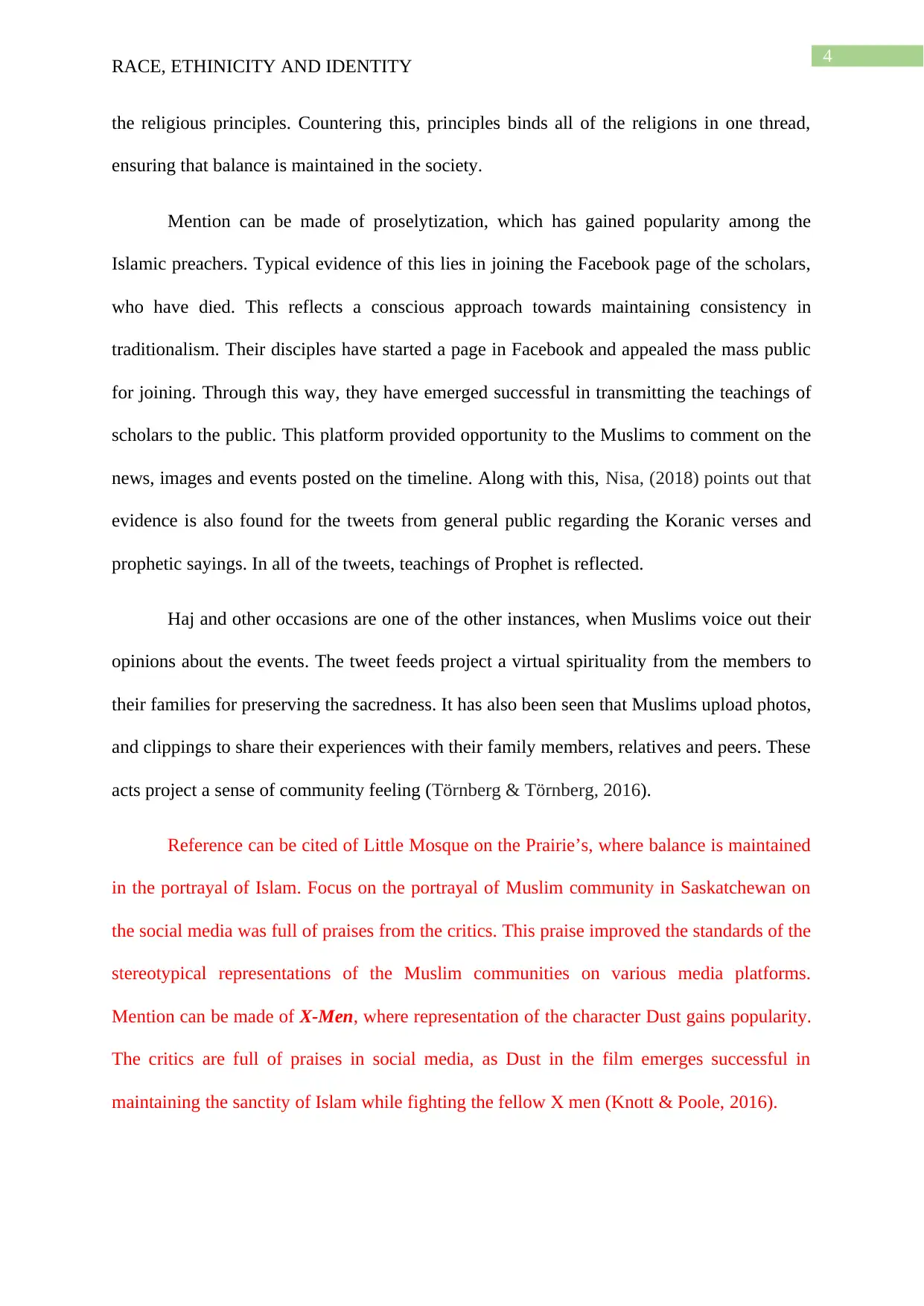
4
RACE, ETHINICITY AND IDENTITY
the religious principles. Countering this, principles binds all of the religions in one thread,
ensuring that balance is maintained in the society.
Mention can be made of proselytization, which has gained popularity among the
Islamic preachers. Typical evidence of this lies in joining the Facebook page of the scholars,
who have died. This reflects a conscious approach towards maintaining consistency in
traditionalism. Their disciples have started a page in Facebook and appealed the mass public
for joining. Through this way, they have emerged successful in transmitting the teachings of
scholars to the public. This platform provided opportunity to the Muslims to comment on the
news, images and events posted on the timeline. Along with this, Nisa, (2018) points out that
evidence is also found for the tweets from general public regarding the Koranic verses and
prophetic sayings. In all of the tweets, teachings of Prophet is reflected.
Haj and other occasions are one of the other instances, when Muslims voice out their
opinions about the events. The tweet feeds project a virtual spirituality from the members to
their families for preserving the sacredness. It has also been seen that Muslims upload photos,
and clippings to share their experiences with their family members, relatives and peers. These
acts project a sense of community feeling (Törnberg & Törnberg, 2016).
Reference can be cited of Little Mosque on the Prairie’s, where balance is maintained
in the portrayal of Islam. Focus on the portrayal of Muslim community in Saskatchewan on
the social media was full of praises from the critics. This praise improved the standards of the
stereotypical representations of the Muslim communities on various media platforms.
Mention can be made of X-Men, where representation of the character Dust gains popularity.
The critics are full of praises in social media, as Dust in the film emerges successful in
maintaining the sanctity of Islam while fighting the fellow X men (Knott & Poole, 2016).
RACE, ETHINICITY AND IDENTITY
the religious principles. Countering this, principles binds all of the religions in one thread,
ensuring that balance is maintained in the society.
Mention can be made of proselytization, which has gained popularity among the
Islamic preachers. Typical evidence of this lies in joining the Facebook page of the scholars,
who have died. This reflects a conscious approach towards maintaining consistency in
traditionalism. Their disciples have started a page in Facebook and appealed the mass public
for joining. Through this way, they have emerged successful in transmitting the teachings of
scholars to the public. This platform provided opportunity to the Muslims to comment on the
news, images and events posted on the timeline. Along with this, Nisa, (2018) points out that
evidence is also found for the tweets from general public regarding the Koranic verses and
prophetic sayings. In all of the tweets, teachings of Prophet is reflected.
Haj and other occasions are one of the other instances, when Muslims voice out their
opinions about the events. The tweet feeds project a virtual spirituality from the members to
their families for preserving the sacredness. It has also been seen that Muslims upload photos,
and clippings to share their experiences with their family members, relatives and peers. These
acts project a sense of community feeling (Törnberg & Törnberg, 2016).
Reference can be cited of Little Mosque on the Prairie’s, where balance is maintained
in the portrayal of Islam. Focus on the portrayal of Muslim community in Saskatchewan on
the social media was full of praises from the critics. This praise improved the standards of the
stereotypical representations of the Muslim communities on various media platforms.
Mention can be made of X-Men, where representation of the character Dust gains popularity.
The critics are full of praises in social media, as Dust in the film emerges successful in
maintaining the sanctity of Islam while fighting the fellow X men (Knott & Poole, 2016).
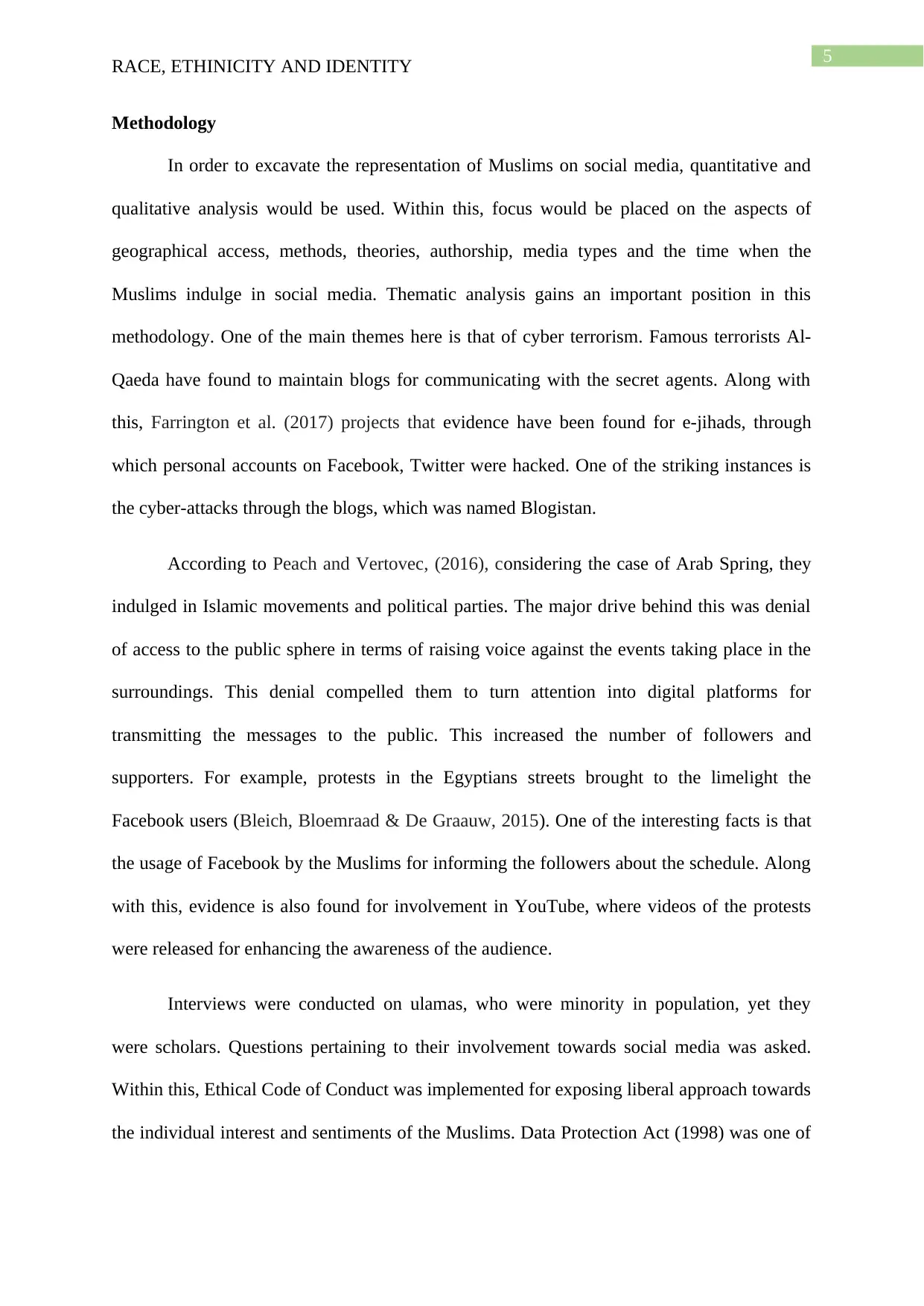
5
RACE, ETHINICITY AND IDENTITY
Methodology
In order to excavate the representation of Muslims on social media, quantitative and
qualitative analysis would be used. Within this, focus would be placed on the aspects of
geographical access, methods, theories, authorship, media types and the time when the
Muslims indulge in social media. Thematic analysis gains an important position in this
methodology. One of the main themes here is that of cyber terrorism. Famous terrorists Al-
Qaeda have found to maintain blogs for communicating with the secret agents. Along with
this, Farrington et al. (2017) projects that evidence have been found for e-jihads, through
which personal accounts on Facebook, Twitter were hacked. One of the striking instances is
the cyber-attacks through the blogs, which was named Blogistan.
According to Peach and Vertovec, (2016), considering the case of Arab Spring, they
indulged in Islamic movements and political parties. The major drive behind this was denial
of access to the public sphere in terms of raising voice against the events taking place in the
surroundings. This denial compelled them to turn attention into digital platforms for
transmitting the messages to the public. This increased the number of followers and
supporters. For example, protests in the Egyptians streets brought to the limelight the
Facebook users (Bleich, Bloemraad & De Graauw, 2015). One of the interesting facts is that
the usage of Facebook by the Muslims for informing the followers about the schedule. Along
with this, evidence is also found for involvement in YouTube, where videos of the protests
were released for enhancing the awareness of the audience.
Interviews were conducted on ulamas, who were minority in population, yet they
were scholars. Questions pertaining to their involvement towards social media was asked.
Within this, Ethical Code of Conduct was implemented for exposing liberal approach towards
the individual interest and sentiments of the Muslims. Data Protection Act (1998) was one of
RACE, ETHINICITY AND IDENTITY
Methodology
In order to excavate the representation of Muslims on social media, quantitative and
qualitative analysis would be used. Within this, focus would be placed on the aspects of
geographical access, methods, theories, authorship, media types and the time when the
Muslims indulge in social media. Thematic analysis gains an important position in this
methodology. One of the main themes here is that of cyber terrorism. Famous terrorists Al-
Qaeda have found to maintain blogs for communicating with the secret agents. Along with
this, Farrington et al. (2017) projects that evidence have been found for e-jihads, through
which personal accounts on Facebook, Twitter were hacked. One of the striking instances is
the cyber-attacks through the blogs, which was named Blogistan.
According to Peach and Vertovec, (2016), considering the case of Arab Spring, they
indulged in Islamic movements and political parties. The major drive behind this was denial
of access to the public sphere in terms of raising voice against the events taking place in the
surroundings. This denial compelled them to turn attention into digital platforms for
transmitting the messages to the public. This increased the number of followers and
supporters. For example, protests in the Egyptians streets brought to the limelight the
Facebook users (Bleich, Bloemraad & De Graauw, 2015). One of the interesting facts is that
the usage of Facebook by the Muslims for informing the followers about the schedule. Along
with this, evidence is also found for involvement in YouTube, where videos of the protests
were released for enhancing the awareness of the audience.
Interviews were conducted on ulamas, who were minority in population, yet they
were scholars. Questions pertaining to their involvement towards social media was asked.
Within this, Ethical Code of Conduct was implemented for exposing liberal approach towards
the individual interest and sentiments of the Muslims. Data Protection Act (1998) was one of
⊘ This is a preview!⊘
Do you want full access?
Subscribe today to unlock all pages.

Trusted by 1+ million students worldwide
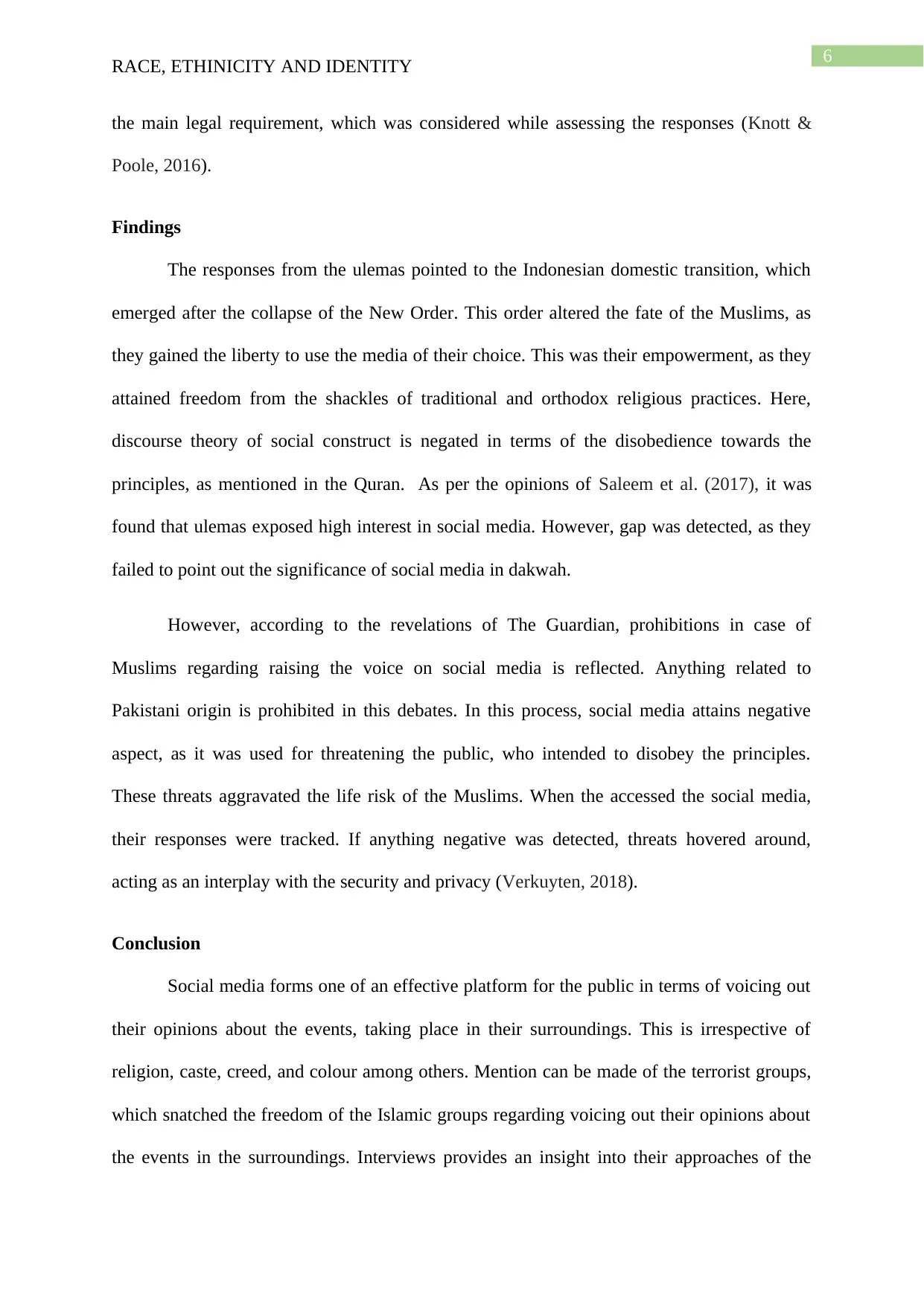
6
RACE, ETHINICITY AND IDENTITY
the main legal requirement, which was considered while assessing the responses (Knott &
Poole, 2016).
Findings
The responses from the ulemas pointed to the Indonesian domestic transition, which
emerged after the collapse of the New Order. This order altered the fate of the Muslims, as
they gained the liberty to use the media of their choice. This was their empowerment, as they
attained freedom from the shackles of traditional and orthodox religious practices. Here,
discourse theory of social construct is negated in terms of the disobedience towards the
principles, as mentioned in the Quran. As per the opinions of Saleem et al. (2017), it was
found that ulemas exposed high interest in social media. However, gap was detected, as they
failed to point out the significance of social media in dakwah.
However, according to the revelations of The Guardian, prohibitions in case of
Muslims regarding raising the voice on social media is reflected. Anything related to
Pakistani origin is prohibited in this debates. In this process, social media attains negative
aspect, as it was used for threatening the public, who intended to disobey the principles.
These threats aggravated the life risk of the Muslims. When the accessed the social media,
their responses were tracked. If anything negative was detected, threats hovered around,
acting as an interplay with the security and privacy (Verkuyten, 2018).
Conclusion
Social media forms one of an effective platform for the public in terms of voicing out
their opinions about the events, taking place in their surroundings. This is irrespective of
religion, caste, creed, and colour among others. Mention can be made of the terrorist groups,
which snatched the freedom of the Islamic groups regarding voicing out their opinions about
the events in the surroundings. Interviews provides an insight into their approaches of the
RACE, ETHINICITY AND IDENTITY
the main legal requirement, which was considered while assessing the responses (Knott &
Poole, 2016).
Findings
The responses from the ulemas pointed to the Indonesian domestic transition, which
emerged after the collapse of the New Order. This order altered the fate of the Muslims, as
they gained the liberty to use the media of their choice. This was their empowerment, as they
attained freedom from the shackles of traditional and orthodox religious practices. Here,
discourse theory of social construct is negated in terms of the disobedience towards the
principles, as mentioned in the Quran. As per the opinions of Saleem et al. (2017), it was
found that ulemas exposed high interest in social media. However, gap was detected, as they
failed to point out the significance of social media in dakwah.
However, according to the revelations of The Guardian, prohibitions in case of
Muslims regarding raising the voice on social media is reflected. Anything related to
Pakistani origin is prohibited in this debates. In this process, social media attains negative
aspect, as it was used for threatening the public, who intended to disobey the principles.
These threats aggravated the life risk of the Muslims. When the accessed the social media,
their responses were tracked. If anything negative was detected, threats hovered around,
acting as an interplay with the security and privacy (Verkuyten, 2018).
Conclusion
Social media forms one of an effective platform for the public in terms of voicing out
their opinions about the events, taking place in their surroundings. This is irrespective of
religion, caste, creed, and colour among others. Mention can be made of the terrorist groups,
which snatched the freedom of the Islamic groups regarding voicing out their opinions about
the events in the surroundings. Interviews provides an insight into their approaches of the
Paraphrase This Document
Need a fresh take? Get an instant paraphrase of this document with our AI Paraphraser
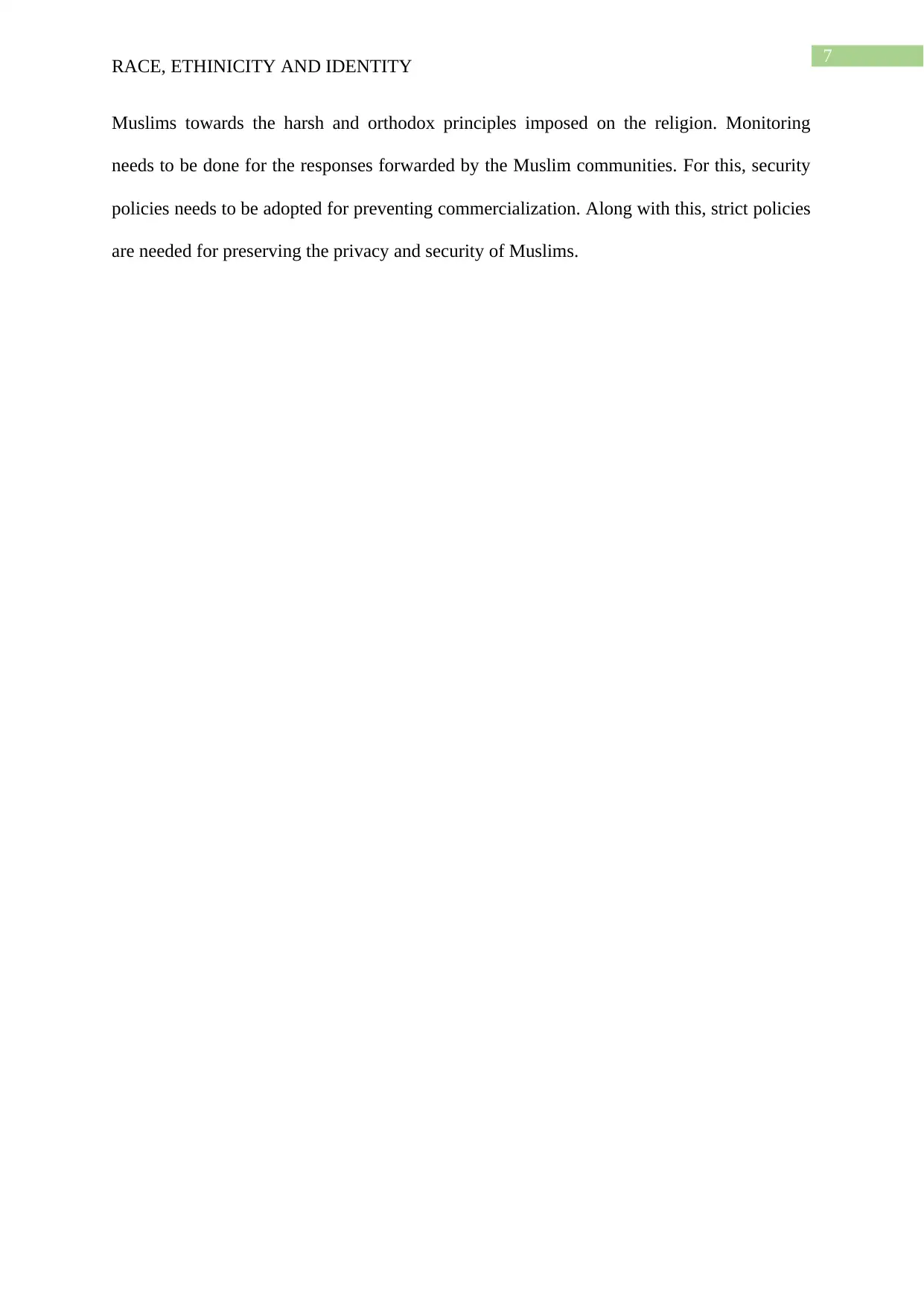
7
RACE, ETHINICITY AND IDENTITY
Muslims towards the harsh and orthodox principles imposed on the religion. Monitoring
needs to be done for the responses forwarded by the Muslim communities. For this, security
policies needs to be adopted for preventing commercialization. Along with this, strict policies
are needed for preserving the privacy and security of Muslims.
RACE, ETHINICITY AND IDENTITY
Muslims towards the harsh and orthodox principles imposed on the religion. Monitoring
needs to be done for the responses forwarded by the Muslim communities. For this, security
policies needs to be adopted for preventing commercialization. Along with this, strict policies
are needed for preserving the privacy and security of Muslims.
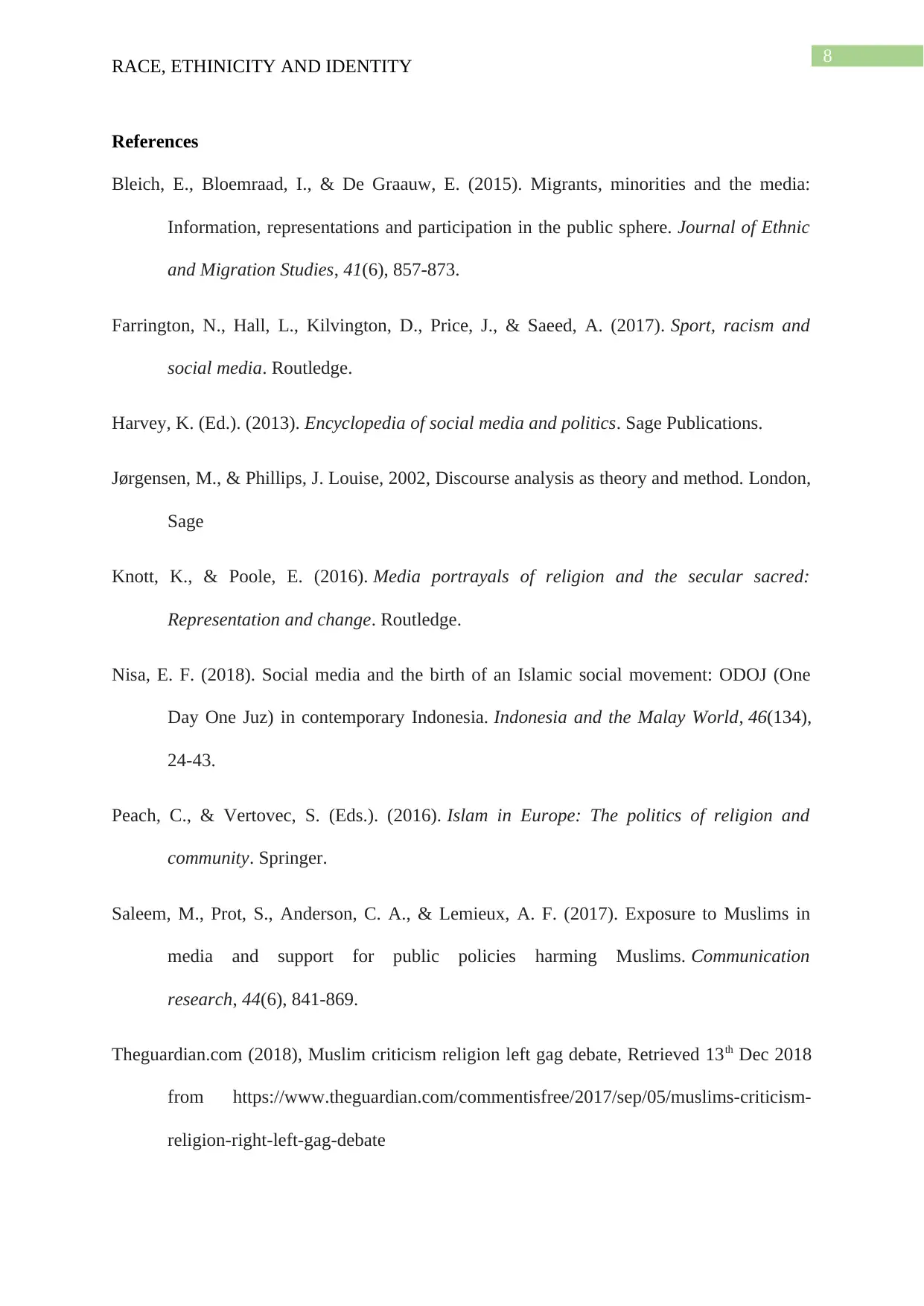
8
RACE, ETHINICITY AND IDENTITY
References
Bleich, E., Bloemraad, I., & De Graauw, E. (2015). Migrants, minorities and the media:
Information, representations and participation in the public sphere. Journal of Ethnic
and Migration Studies, 41(6), 857-873.
Farrington, N., Hall, L., Kilvington, D., Price, J., & Saeed, A. (2017). Sport, racism and
social media. Routledge.
Harvey, K. (Ed.). (2013). Encyclopedia of social media and politics. Sage Publications.
Jørgensen, M., & Phillips, J. Louise, 2002, Discourse analysis as theory and method. London,
Sage
Knott, K., & Poole, E. (2016). Media portrayals of religion and the secular sacred:
Representation and change. Routledge.
Nisa, E. F. (2018). Social media and the birth of an Islamic social movement: ODOJ (One
Day One Juz) in contemporary Indonesia. Indonesia and the Malay World, 46(134),
24-43.
Peach, C., & Vertovec, S. (Eds.). (2016). Islam in Europe: The politics of religion and
community. Springer.
Saleem, M., Prot, S., Anderson, C. A., & Lemieux, A. F. (2017). Exposure to Muslims in
media and support for public policies harming Muslims. Communication
research, 44(6), 841-869.
Theguardian.com (2018), Muslim criticism religion left gag debate, Retrieved 13th Dec 2018
from https://www.theguardian.com/commentisfree/2017/sep/05/muslims-criticism-
religion-right-left-gag-debate
RACE, ETHINICITY AND IDENTITY
References
Bleich, E., Bloemraad, I., & De Graauw, E. (2015). Migrants, minorities and the media:
Information, representations and participation in the public sphere. Journal of Ethnic
and Migration Studies, 41(6), 857-873.
Farrington, N., Hall, L., Kilvington, D., Price, J., & Saeed, A. (2017). Sport, racism and
social media. Routledge.
Harvey, K. (Ed.). (2013). Encyclopedia of social media and politics. Sage Publications.
Jørgensen, M., & Phillips, J. Louise, 2002, Discourse analysis as theory and method. London,
Sage
Knott, K., & Poole, E. (2016). Media portrayals of religion and the secular sacred:
Representation and change. Routledge.
Nisa, E. F. (2018). Social media and the birth of an Islamic social movement: ODOJ (One
Day One Juz) in contemporary Indonesia. Indonesia and the Malay World, 46(134),
24-43.
Peach, C., & Vertovec, S. (Eds.). (2016). Islam in Europe: The politics of religion and
community. Springer.
Saleem, M., Prot, S., Anderson, C. A., & Lemieux, A. F. (2017). Exposure to Muslims in
media and support for public policies harming Muslims. Communication
research, 44(6), 841-869.
Theguardian.com (2018), Muslim criticism religion left gag debate, Retrieved 13th Dec 2018
from https://www.theguardian.com/commentisfree/2017/sep/05/muslims-criticism-
religion-right-left-gag-debate
⊘ This is a preview!⊘
Do you want full access?
Subscribe today to unlock all pages.

Trusted by 1+ million students worldwide
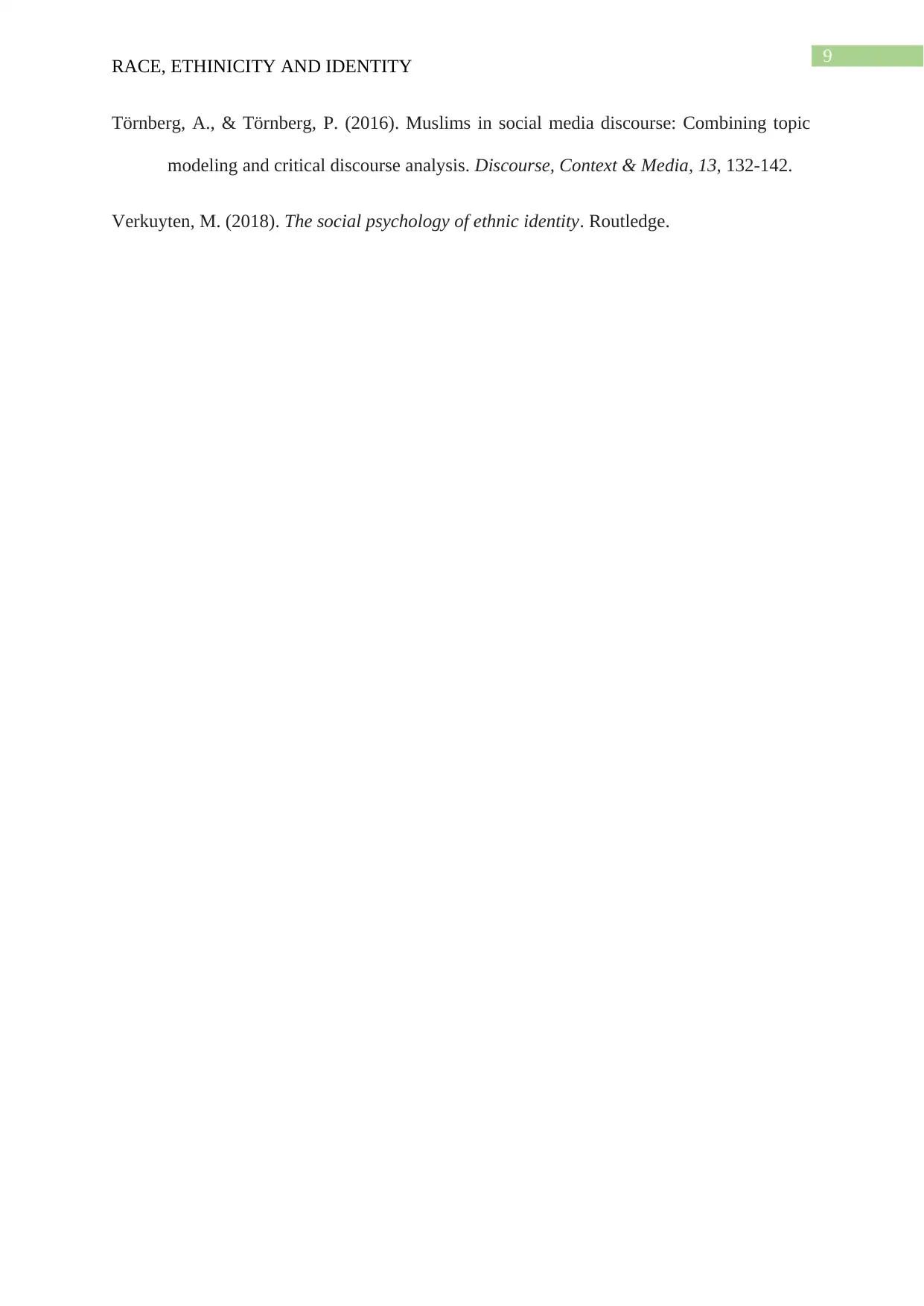
9
RACE, ETHINICITY AND IDENTITY
Törnberg, A., & Törnberg, P. (2016). Muslims in social media discourse: Combining topic
modeling and critical discourse analysis. Discourse, Context & Media, 13, 132-142.
Verkuyten, M. (2018). The social psychology of ethnic identity. Routledge.
RACE, ETHINICITY AND IDENTITY
Törnberg, A., & Törnberg, P. (2016). Muslims in social media discourse: Combining topic
modeling and critical discourse analysis. Discourse, Context & Media, 13, 132-142.
Verkuyten, M. (2018). The social psychology of ethnic identity. Routledge.
1 out of 10
Your All-in-One AI-Powered Toolkit for Academic Success.
+13062052269
info@desklib.com
Available 24*7 on WhatsApp / Email
![[object Object]](/_next/static/media/star-bottom.7253800d.svg)
Unlock your academic potential
Copyright © 2020–2025 A2Z Services. All Rights Reserved. Developed and managed by ZUCOL.